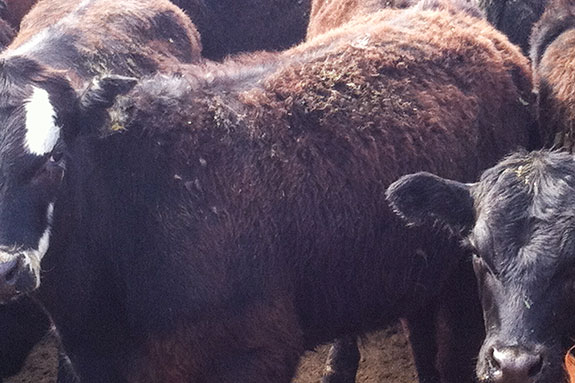Mineral supplementation can help ranchers avoid cattle health problems due to mineral deficiencies.
Mineral deficiencies seldom cause death, but performance of the animal is often reduced to a level that results in economic losses. These losses are often more costly than is readily apparent.
While the contribution of a mineral program to the bottom line is not always apparent, the lack of one will soon show up through decreased production, efficiency and profitability.
In many cases, apparent production and health problems can be corrected by simply identifying one or more mineral deficiencies or imbalances.
Most mineral programs will cost $25 to $35 per cow annually and can be viewed as a relatively cheap insurance policy against excess disease or money lost due to poor performance.
Animal health and immune function
Animal health can be described as the maintenance of normal physiological functions that allow for a productive existence.
Many components must work together to maintain a “steady state” in the animal.
The availability of mineral components in the diet is one very important part of this overall picture.
Another is that an animal’s immune system be maintained. A proper plane of nutrition is required for cattle to produce antibodies and lymphocytes to initiate an immune response.
If the immune system is not functioning, an animal cannot resist the various pathogens in their environment.
Additionally, without an effective immune system, no amount of vaccination can compensate for a deficiency.
Several trace minerals have been identified as necessary for proper immune function in cattle. Most trace minerals are essential for enzyme activity for energy production, protein synthesis and cell replication.
In addition, several trace mineral-dependent enzymes act specifically within the immune system, such as those removing free radicals from the body.
The main trace minerals involved in the immune function of cattle include copper, zinc and selenium.
These three trace minerals are also the most likely to be deficient in cattle diets and require supplementation.

Copper: Copper deficiency can result in decreased numbers of antibody-producing cells that reduces the ability to fight off antigens.
Without enough copper, calves’ immune systems may be inadequate at weaning, leading to unnecessary sickness.
Cattle are often copper-deficient because much of the forages they consume contain high levels of antagonists such as molybdenum, sulfates and iron.
While these minerals are also necessary for the animal, they will prevent cattle from absorbing copper when present in moderate or excessive amounts.
Very often, cattle are subclinically copper-deficient. Clinical signs of a copper deficiency will most often be denoted by a “rusty” appearance on black-hided cattle or from a lack of shedding the winter coat.
Copper is one of the hardest minerals to keep out of a deficient level due to low volumes of copper in most forages, as well as the frequent presence of high levels of antagonists.
Zinc: Zinc deficiencies can leave calves shy in both immune response and muscle growth.
Clinical symptoms of zinc deficiency include reduced feed intake and skin lesions. Stressed cattle that are zinc-deficient will typically demonstrate higher levels of sickness, less response to treatment and longer recovery times than those cattle that have adequate levels of zinc in their system.
Zinc has an interdependent relationship with copper in that increasing the supplementation of both of the minerals together will result in a greater increase in zinc levels in the cow than supplementing for zinc alone.
Selenium: Without enough selenium, calves can develop “white-muscle disease” that weakens muscles throughout their bodies, including their hearts.
Clinical symptoms of selenium deficiency include retained placentas after calving and weak calves or nutritional muscular dystrophy (white-muscle disease).
Selenium works in tandem with vitamin E, and both are critical for reducing the risk of the above-mentioned symptoms. Symptoms can be avoided or treated with an injection of bovine selenium.
Good nutrition equals healthy animals
Cattle producers understand the importance of keeping cattle healthy. A good herd health program is an essential part of any ranch management program which can have a big impact on profit margins.
Developing a good herd health program is centered around disease prevention, diagnosis and treatment. However, a good herd health program will not be effective without a good nutritional program as well.
Management strategies for a good herd health program should focus on minimizing stress on the animal, including nutritional stress.
It has been demonstrated that stress compromises immune function; thus, efforts should be made to support the animal’s immune systems through proper nutrition.
A properly functioning immune system will fight off immune challenges from the environment, enable vaccines to be more effective at preventing future health problems and will help to avoid economic losses due to morbidity, mortality and decreased performance.
Developing an effective mineral supplementation program
Mineral supplementation programs are a point of confusion for many ranchers. Ranchers are often at a loss as to how to assess mineral deficiencies, which mineral packages they need to purchase, if they should have a custom mineral mix prepared, how much to feed, what type to feed and how much it is going to cost.
With the flood of information that ranchers can receive on this topic from sales representatives, university researchers (or extension folks), cattle buyers and numerous others, it is easy to understand the confusion.
Animals cannot synthesize minerals and therefore must obtain them from their feed. The majority of a cow’s nutrient intake, including minerals, comes from growing or dormant forage.
However, forages are highly variable in mineral content. Contributors to this variability can include environmental conditions, fertilization or previous use of land.
Mineral requirements of cattle also vary by phase of production, stress factors and life stage of the animal, as well as a host of other factors.
These factors can create a highly complex feeding or supplementation scenario for the rancher.
What should you do to make sure your mineral program is actually contributing to your overall herd health program? Some steps include:
- Take measures to assess your herd’s mineral status.
- Test feeds to determine what minerals your cattle are ingesting.
- Work with your local extension agent or industry nutritionist to develop a mineral program that is right for your herd and your management plan.
No two operations are the same, and what works for you may not work for your neighbor. - Follow the label guidelines on the mineral you choose.
- Don’t risk the financial consequences of an inadequate mineral program.
It is vitally important for cattlemen, whether they are commercial or purebred producers, stocker cattle operators or feedyard managers, to develop and implement a sound mineral program in order to keep their cattle healthy, which will lead to a productive and profitable operation. ![]()
Billy Whitehurst is an extension educator with the University of Idaho Extension, Twin Falls County
PHOTOS
These pictures show examples of copper-deficient cattle. Note the rusty-colored hair coat on the black cattle, and the yellowish haze to the coat on the red calf. All have rough-looking coats that should have shed at this point in the year. Photos courtesy of Billy Whitehurst, University of Idaho Extension.









